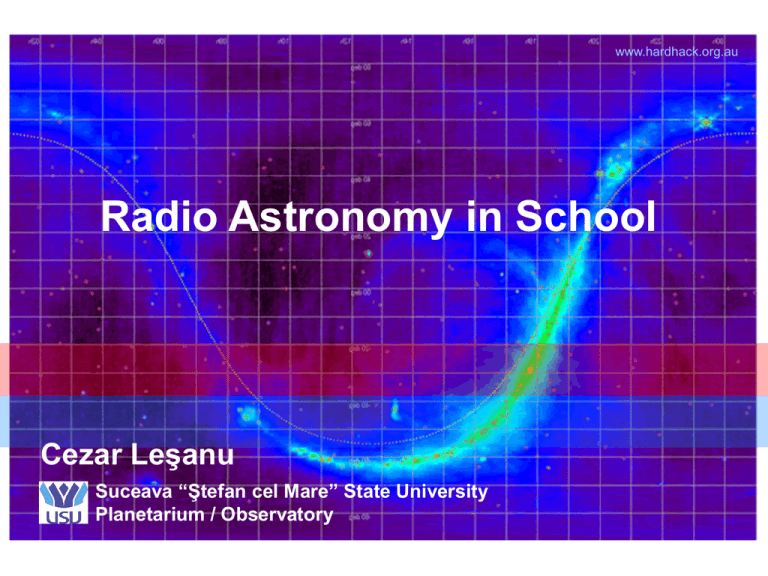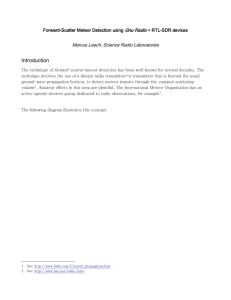Radio Astronomy in School Suceava “Ştefan cel Mare” State
advertisement

www.hardhack.org.au Radio Astronomy in School Cezar Leşanu Suceava “Ştefan cel Mare” State University Planetarium / Observatory Electromagnetic spectrum Atmospheric electromagnetic opacity www.wikipedia.com We highlight some radio astronomy projects promoted by renowned institutions around the Globe, relatively accessible in terms of level of knowledge required, availability of the equipment, and investment. These projects are addressed to high school and university students as well as to amateur astronomers, and involve the participants in a wide range of hands-on activities, from building, assembling, and calibrating the hardware setup to analyzing and sharing the data over the internet, all in a interdisciplinary learning process. Interactive NASA Space Physics Ionosphere Radio Experiments" • is a non-profit scientific, educational corporation, founded in 1989 by a team of NASA employees • investigation of very low frequency (VLF = 0 Hz to over 100 kHz) radio signals in the earth's magnetosphere • These signals are both manmade and naturally occurring (most of which originate from lightning) INSPIRE VLF3 receiver kit http://www.tnskynet.com Field observation setup: • INSPIRE VLF3 receiver with stereo cable • Portable cassette tape recorder with headphones • Whip antenna • Ground stake Links • INSPIRE project home page http://theinspireproject.org/ • “Listening to Northern Lights” Video http://www.youtube.com/watch?v=eHvdZdsIZxg • Live VLF Natural Radio Streaming http://abelian.org/vlf Radio Meteor Observation • meteoroids disintegrate at an altitude of 80 to 130 km • the trails they leave behind are full of ionized gases that reflect radio waves • distant VHF(30MHz-300MHz) radio signals can bounce off the meteor trail (forward scattering method) • can monitor meteor activity regardless the weather conditions and at daytime Radio detection of meteors Transmitter Continuous wave (FM carrier) Receiving station Radio Meteor Observation Experimental setup Black box FM radio receiver with digital frequency readout + PC interface ( SSB receiver + PC soundcard ) Radio detection of meteors at “Nights of Perseids” festival,Horodnic 2008/2009. Radio Meteor Observatory On Line at USV Links • International Meteor Organization http://www.imo.net/radio • The G7IZU Radio Reflection Detection Page http://www.tvcomm.co.uk/radio/ • “Meteormania” Video – BBC 4 TV http://www.tvcomm.co.uk/radio/video/meteormania.wmv • Radio Meteor Observatory's On Line http://www.rmob.org/index.php SID Sudden Ionosphere Disturbance monitor • is an education project to build and distribute inexpensive ionospheric monitors to students around the world • the monitors detect solar flares and other ionospheric disturbances • Earth's ionosphere reacts strongly to the intense x-ray and ultraviolet radiation released by the Sun during a solar event • the signal strength from a distant VLF transmitter, reflected by ionosphere, will follow this changes Super SID Receiver - simple and low-cost Super SID (New SDR based VLF receiver) “wire-loop antenna” Links • Stanford Space Weather Monitor program http://solar-center.stanford.edu/sid.html • Society of Amateur Radio Astronomers http://www.radio-astronomy.org/node/142 • Tennessee SkyNet Observatory http://www.tnskynet.com/SID-VLF.php NASA Radio Jove Project • was conceived in 1997 by a team headed by Jim Thieman at Goddard Space Flight Center • sold its first receiver kit 1999 (10th anniversary – almost 1400 kits sold) • observe and analyze natural radio emissions of Jupiter (bursts), the Sun (Solar flares), and our galaxy (transit) • Frequency of operation 20.1 MHz • Receiver type: direct conversion (a hamradio transceiver can be used – expensive) • Antenna: dipol λ/2 or phased dipol or multi-element http://fringes.org/ phased dipole antenna Radio-SkyPipe Software - An Internet Enabled Strip Chart Recorder http://www.radiosky.com Radio Jove at ATLANTYKRON Summer Academy 2005 50th anniversary of the discovery of Jupiter's natural radio emissions Links • NASA Radio Jove Project http://radiojove.gsfc.nasa.gov/ • The Internet Jupiter Radio Observatory Kochi JP http://jupiter.kochi-ct.jp/ • Radio bursts from Jupiter video - CFARO http://www.youtube.com/watch?v=H6wkt_8a-6A • Radio burst from the Sun – CFARO http://www.youtube.com/watch?v=smuHQzDy3i0 Small total power radio telescope Offset TV satellite dish Data acquisition board Computer + data logging software LNB Power Supply Analog satellite finder (modified) 14-18V DC • Detect microwaves emitted by the Sun and approximate the temperature at 11GHz (chromosphere) • Detect microwaves emitted by the human body or any other object of sufficiently high temperature. First test - 2006 Meridian transit of the Sun at 11GHz (Ku band) Panaci 2009 Suceava Panetarium 2009 The Internet Solar Radio Observatory Imai Laboratory, Kochi National College of Technology, Japan http://sun.kochi-ct.jp/e/observatory.html Links • MIT Very Small Radio Telescope (VSRT) http://www.haystack.mit.edu/edu/undergrad/VSRT/index.html • Radio Astronomy on 11 GHz at ISU http://astro.u-strasbg.fr/~koppen/10GHz/index.html • The Internet Solar Radio Observatory http://sun.kochi-ct.jp/e/observatory.html











